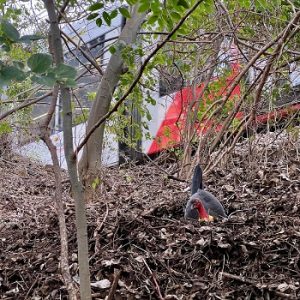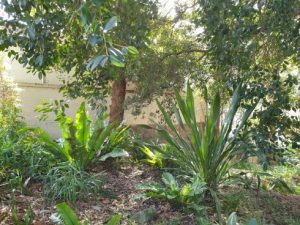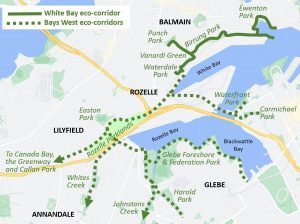by Andrew Wood, Blue Wren Subcommittee Convenor, from Bulletin 7/2022, September 2022

The Subcommittee has 16 members and met on six occasions over the last 12 months. Our oldest member, Norma Disher-Hawkins, turned 99 in October last year and the Society arranged for the City to plant a Melaleuca linariifolia in her honour in John Street Reserve close to her house in St James Ave. Since moving to Glebe over 40 years ago, Norma has made outstanding contributions to the wider community and to Glebe, especially in the establishment of the biodiversity garden in the Reserve.
As far as we know, there are no superb fairy wrens resident in Glebe. In February this year, however, a Society member from Hereford St (not far from Paddy Gray Reserve) saw male and female wrens in the front garden. Dr Holly Parsons (Program Co-Manager, Birds in Backyards) says we don’t know how far wrens will travel to disperse after breeding – although distances of around 5 km could be expected. The previous sighting was in May 2021 when a pair of wrens were seen in the native flora on the foreshore walk in front of the Anchorage home units.

The Society’s 8th Annual Spring Bird Survey was held in November 2021 and was led as usual by Judy Christie. It was our largest team of surveyors with 20 people taking part, counting birds for 20 to 45 minutes in 11 different parts of Glebe and Forest Lodge. Not surprisingly, with the additional people to count birds and more parts of Glebe and Forest Lodge covered – as well as the inclusion this year of Lake Northam in Victoria Park – we found 970 birds of 28 species (last year it was 623 birds of 26 species).
The two most common birds again were the native Noisy Miner and the Rainbow Lorikeet. The Noisy Miner continues to dominate all our open spaces and numerous nests have been seen. The Australian Magpie numbers jumped significantly and again they seem to be breeding wherever there are the tall trees that they prefer for nest sites. Pied Currawongs are also breeding locally and increasing, feeding on fleshy fruited trees such as figs and especially the now common street-planted Tuckeroo (Cupaniopsis anarcardiodes), as well as weedy species like Privet (Ligustrum spp) and particularly Celtis (Celtis australis). Among the non-native species the biggest increase was in numbers of Feral Pigeons, now called Rock Dove, reflecting their original origins in Europe on rocky cliffs. This year’s survey will be held on Sunday 23 October and all members and friends are welcome to attend.
Also, earlier this year Sydney Water completed its naturalisation work on Johnstons creek/canal and it is wonderful to report that fauna (fish, pelicans, turtles, eels, ducks and herons) has returned. In a survey, Nick and Janice Sangster counted 219 birds of 12 species along the creek.

Following the City’s extensive upgrade of Palmerston Steps, four volunteers led by Anna Szanto continue the work of the Glebe Palmerston and Surrounds Landcare Group in caring for the parks. The Orphan School Creek Bushcare Group has 20 volunteers who attend regular planting days and working bees. It is led by Judy Christie. Other parks in Glebe are maintained principally by the City’s contractors (Skyline Landscape Services and the National Trust’s Bushland Management Services); however, the Subcommittee maintains a watching brief over each and the details are as follows: Paddy Gray Reserve (Bryan Herden), John Street Reserve (Norma Hawkins and Bob Richards), Bicentennial and Federal Parks (David Lawrence) and Harold Park (Nick and Janice Sangster).
There are 14 schools and preschools in Glebe and each received an invitation to apply for a 2021 Craney Small Grant to support a biodiversity project in their school. Three grants were awarded and successfully completed during the year: Glebe Public School (Glebe Public School Environment Project), Glebe SDN (Native plant vertical garden), and Explore and Develop (Connecting to Country through classroom ecosystems). Applications for the 2022 round of grants will close in November this year.

The Society’s 7th Annual Biodiversity Lecture entitled ‘How nature survives and thrives in urban environments, and why it matters for the future of our cities’ was given in May by Professor Dieter Hochuli from the School of Life and Environmental Sciences, Faculty of Science at the University of Sydney and leader of the Integrative Ecology Group. Helen Randerson reported that some of Dieter’s research has focused on the wellbeing benefits of engaging with nature. In an urban setting, how accessible and close it is (‘nature near you’) seems to be more important than how good it actually is. Research on the benefits of urban trees has shown that there are both heat and biodiversity benefits, whilst research on urban children’s connections to nature has shown significant differences with both age and gender, pointing to the need to find new ways to engage children. A forthcoming book by Dieter and colleagues, Creatures in Your Neighbourhood will try to encourage everyone to look at what’s happening ‘under their own noses’ – in their local environments.
The Subcommittee has also helped prepare the Society’s responses to various City and State Government plans. The City’s Draft Plans of Management for Glebe’s crown lands (General Crown Reserves Draft Plan of Management, Wentworth Park Draft Plan of Management and Johnstons Creek Parklands Draft Plan of Management) were commented upon in December 2021. In its submission the Society stated:
The City’s management of the Crown Lands in Glebe and Forest Lodge, as remnants and reconstructed landscapes of rare green open space in a densely built city, provides opportunities for a renewed commitment to Indigenous sustainable management principles of ‘Caring for Country’. These management practices should support the health and well-being of the land (‘country’), in recognising Aboriginal custodianship of these lands, and local Aboriginal expertise should be sought where possible. The planting and maintenance of diverse native plant species to provide shade and habitat, a mix of native grasses, shrubs, small trees, ’native meadows’ (as at Prince Alfred Park), dense small bird habitat and re-establishment of original vegetation (where appropriate) should be encouraged to promote biodiversity, environmental awareness, and a sense of continuity with Sydney’s pre-1788 history.
Of particular interest is the future of The Hill, a site of fenced contaminated land (a former garbage tip) on the northern side of the Tramsheds. The Society is proposing that it become an undisturbed urban nature refuge and has received support from the City to monitor the existing wildlife on the site by the use of cameras and acoustic recording devices (for detecting bats).

The Subcommittee worked with Keith Stallard, a Society member and resident of Balmain, on the Department of Planning, Industry and Environment’s Bays West Place Strategy. Keith proposed, with the support of the Society, that a wildlife eco-corridor should be established as an essential and important part of the Strategy and that it should include links to similar corridors in Glebe, Annandale and Callan Park. The President, Ian Stephenson, said that the important and necessary initiatives proposed in Keith’s proposals are entirely aligned with the Society’s biodiversity objectives which include: increasing the diversity, abundance and distribution of indigenous fauna and flora; establishing a network of wildlife corridors linking key habitat areas; and involving the local community in habitat creation, enhancement activities and public education on the importance of biodiversity.
At present the Subcommittee is helping to prepare the Society’s comments on the City’s 2022 Draft Street Tree Master Plan which will be submitted later this year.








There are no comments yet. Please leave yours.